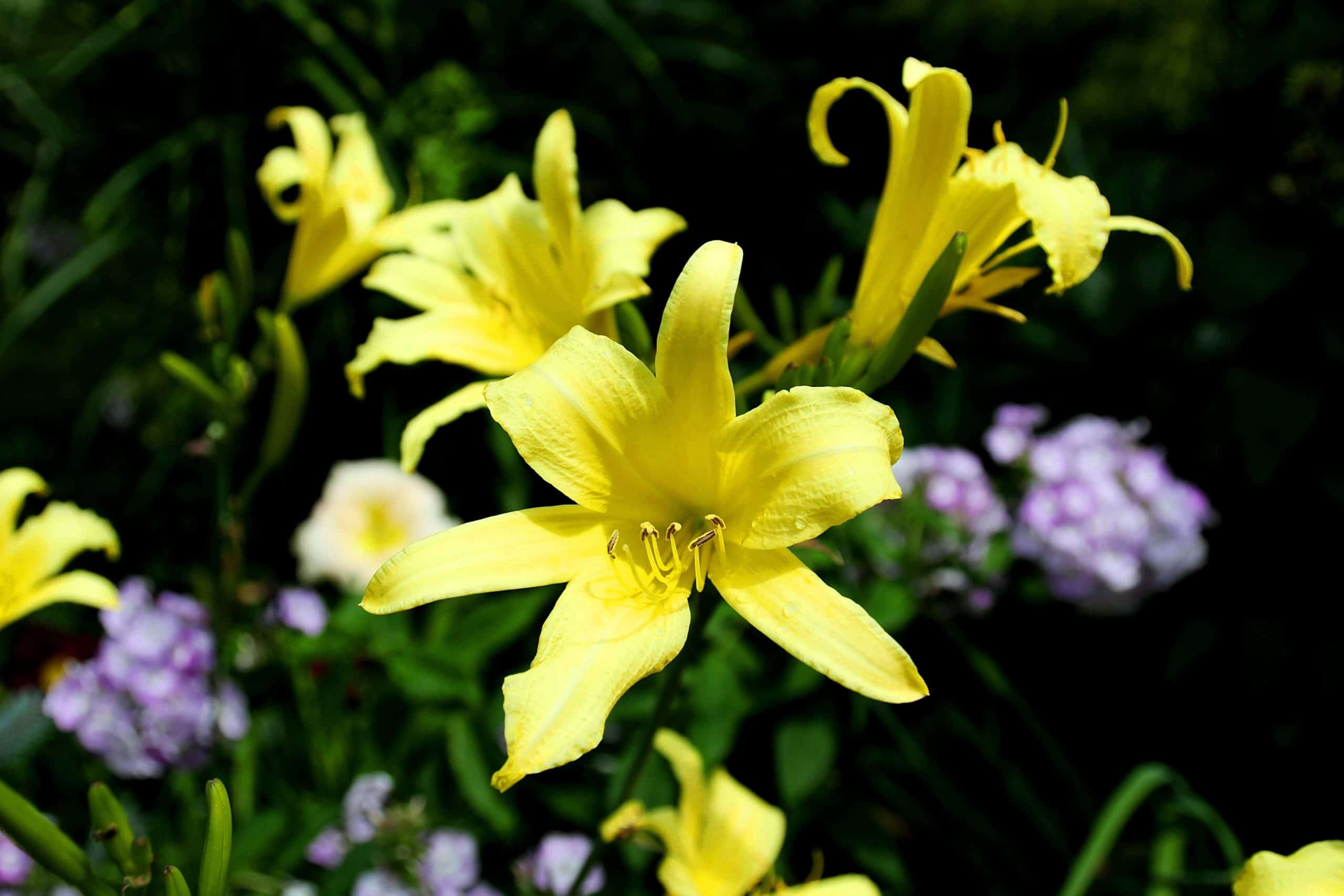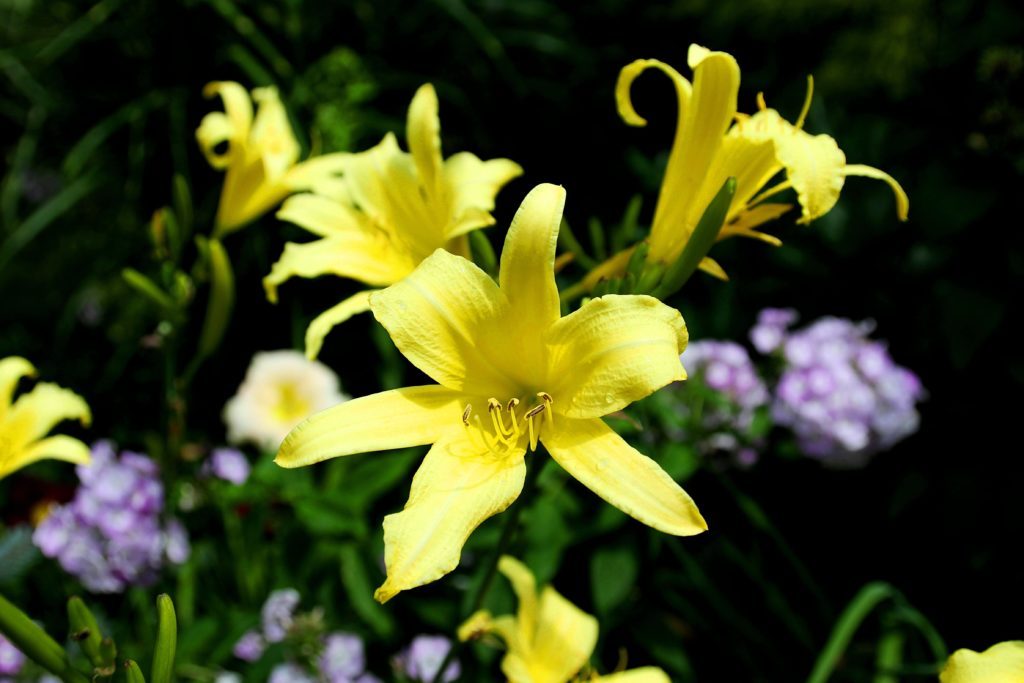
Surveying the garden through a window one morning this week, I expected to see a nice stand of ‘Hyperion’ daylilies, noted for their canary-yellow colour and sweet scent. There they were, but with a nemesis in their midst that nearly sent me rocketing through the glass—the dreaded dog-strangling vine (Vincetoxicum nigrum), sometimes known as black swallow-wort, a scrambling and climbing vine with enough vigour to overtake perennials and shrubs in its path. Dog-strangling vine spreads effectively by seed and underground roots, forming roiling masses of vegetation with inconspicuous flowers that become prominent clusters of long, pointed seedpods. The pods ripen and burst open to reveal brownish seeds, each with its own silky parachute. And every one of them grows. Before I’m responsible for canines gone missing in the flower borders, I guess it’s time for a late summer garden cleanup.
The summer’s prolific heat has combined with my persistent irrigation and produced masses of growth. Everything is full, heavy and hanging down, but the foliage colours are beginning to look weary and flowering plants have peaked early and are now exhausted. Weeds of every kind have reproduced effectively and spread to make new colonies. Yellow avens (Geum aleppicum) is a particular nuisance in my garden, and I can’t find a patch it hasn’t invaded. Creeping buttercup (Ranunculus repens) has run all through the feet of a beech hedge and infiltrated the new front lawn.
Action is needed in other areas, too. I’ll empty containers of exhausted coleus and begonias, top up the planting mix, and prepare for a fall display of ornamental cabbage, kale and chrysanthemums. Some containers with still vigorous plants need grooming, and I’ll cut back leggy petunias and fertilize. Spent flowers on perennials and shrubs need to be deadheaded. The lawn edge has melted away and needs to be sharpened again. Trees have grown together, forming a light canopy, and I need to get out the pole pruner and restore their individual profiles. It will be September before I get around to serious weeding, but there’s plenty to do now. It seems the garden has gotten away from me, but I’m pressing the pedal to the metal, so to speak, and intend to get it back in shape for a long, luxurious and productive autumn.
Growing autumn spinach
I won’t tell you what I recently paid for an imported box of baby spinach leaves in the market, but it was a small shock. In my vegetable-friendly household, that box is barely sufficient for one meal’s salad. Spinach is easy and quick to grow, and I could plant it myself when the season turns toward autumn later this month.
Spinach loves cool weather, and starting a late-summer crop would be a pleasure to have for the kitchen. You can order seed online and be ready to start your spinach seed by the middle of August.
Spinach can be direct seeded into the ground, or into containers on decks and patios. Transplants can be started indoors in clean plastic cell trays for transplanting into the garden later.
There are so many kinds of spinach I might grow. Perusing seed company websites (try stokeseeds.com, damseeds.ca and veseys.com), right away I noticed ‘Regal’, a semi-savoy spinach with erect four-inch (10-cm) leaves, used for the baby spinach leaf market (44 days to harvest of fully mature plants), and recommended for fall planting. I can imagine how those little leaves standing upright are easily cut and bagged.
Quickest to grow is semi-savoy ‘Viceroy’ (40 days to maturity), with a slightly crinkled, medium green leaf that can be cut in the baby stage. Two smooth leaf varieties used for baby leaf harvesting are ‘Tortoiseshell’ and ‘Space Hybrid’ (both 50 days to maturity). ‘Scarlet’ (44 days to maturity) has a unique red vein down the middle of each leaf. For a traditional spinach to be harvested at the tall and multi-stem stage, ‘Longstanding Bloomsdale’ has exceptionally dark green leaves with the most crumpled savoying of any variety (55 days to maturity).
Spinach likes to grow in soft, organic soil with consistent moisture. You can amend the growing area with composted manure and small or shredded leaves, and plant the seeds ½ inch (1 cm) deep, spaced every three inches (8 cm) for baby leaf or seedling plant harvesting. To harvest mature plants, space the plants six inches (15 cm) apart. Seed can be planted in mid-August, with subsequent staggered plantings every seven days through mid-September. Be sure to keep the bed (or containers) moist at all times as spinach won’t tolerate dry soil.
They will probably reach baby leaf cutting size after about 30 days, when the little crowns are showing about three to four leaves each. When cutting baby leaves, use a pair of sharp scissors to cut leaves, and be careful not to injure the plant’s crown. The seedling spinach plants will continue to send up small crisp leaves from the crown for additional cutting. Staggered plantings will give you little plants right through autumn. If temperatures dip below 5°C, protect the plants from overnight frost with a spun fibre row cover (available from seed companies) and keep the leaves growing for weeks more.










Judith,
Thanks for sending me your blog, I just posted it on my facebook page